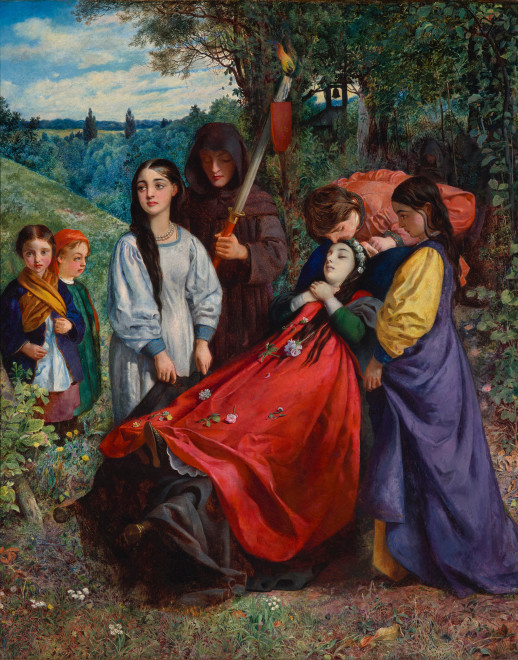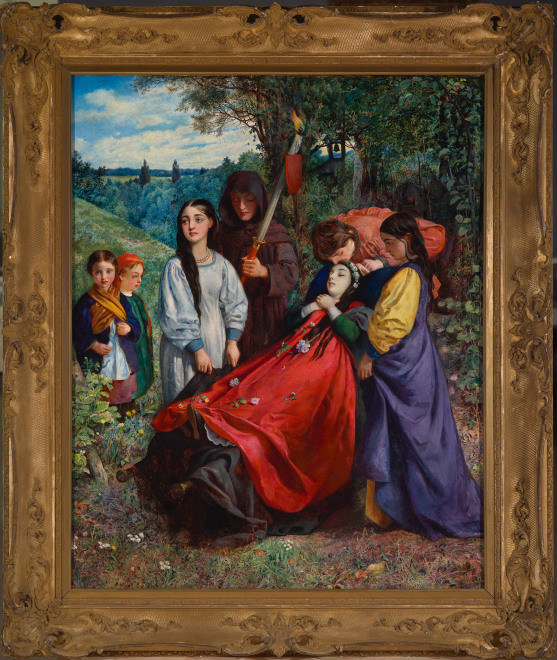Provenance
Sale: Sotheby's, New York, October 30, 1980, lot 34
Andrew Lloyd Webber, London
Exhibited
London, Royal Academy, 1859. no. 831
London, Shepherd's Gallery, ca.1898
London, Royal Academy of Arts, Pre-Raphaelite and Other Masters : the Andrew Lloyd Webber Collection, September 20th - December 12th, 2003, no. 75, p.111 (ill.)
Literature
Athenaeum, no. 1647, May 21, 1859, p. 63
Storey, G.A., Sketches from Memory, London, 1899, p. 106
Bate, P.H., The English Pre-Ralphaelite Painters, London, 1899, p. 87.
Catalogue note
In his autobiography, Sketches from Memory, published in 1899, George Adolphus Storey discussed his early admiration for the Pre-Raphaelites and especially John Everett Millais, exclaiming that they (the Pre-Raphaelites) “woke a new interest in art, showing that it is a living thing continually growing and throwing out new forms and fashions and ideas, new interpretations of nature, new combinations of colour, and new methods of workmanship.” (Storey, 1899, p. 105-6).
After seeing Millais’s “most poetical” Autumn Leaves (Manchester City Art Gallery, Manchester) at the Royal Academy in 1856, Storey was inspired to paint The Bride’s Burial, or as he also referred to it in his autobiography, The Burial of Juliet. Exhibited at The Royal Academy in 1859, the critics were unanimous in their praise for Storey’s Bride - “Two Pre-Raphaelite pictures by Storey when he was in this twenty-first year come as revelations. They are delightful in colour, rich and voluptuous and excellent in sentiment. “(from Public Opinion, quoted in Storey, p. 118). The Daily News commented: “But more interesting are some very early works by G.A Storey, A.R.A. which show that this artist was once amongst the disciples of the Pre-Raphaelite Brotherhood. The pictures here resemble somewhat in strength and brilliancy of colour some of the first works of Millais.” (Storey, p. 118). And finally, from The Morning Post, “Among the modern pictures are two by Mr. G.A. Storey, probably the best he has ever painted, ‘Juliet’…remarkable for beauty of colour, poetic grace of design, and general deftness of execution.” (Storey, p. 118).
The description accompanying the painting in The Royal Academy exhibition was taken from the first sonnet in chapter VIII of Dante’s Vita Nuova: “Mark now what honour she received from love: /I saw him leaning o’er her beauteous corpse,/Lamenting in sincerity of grief;/And oft he cast a wistful look to heaven,/ Where now that gentle spirit finds its rest, /That lady was of countenance so gay.’
A comparison between Storey’s Bride and Millais’s Ophelia, exhibited at The Royal Academy in 1852 cannot be denied. Understanding Storey’s admiration for Millais, it is not surprising he found the subject of death, especially death of a beautiful young woman, an appealing topic, not to mention the similarity of prose between Shakespeare and Dante in the descriptive text. But perhaps of greater significance is Storey’s detailed, almost botanical emulation of Millais’ flora and foliage in Ophelia. Storey himself commented in his autobiography: “Millais’ admirers did not copy Millais’ pictures, they only tried to copy nature as he did.” (Storey, p. 106).
Storey’s all too brief love affair with the Pre-Raphaelite Brotherhood most likely resulted in his name fading from posterity. He later fell under the influence of Charles Robert Leslie and became a member of the St. John’s Wood Clique, whose subjects included scenes of historic genre. This group had been largely forgotten by the early 20th century. We can only speculate how Storey’s work would have evolved had he continued to paint pictures like The Bride’s Funeral.
There is a preliminary oil study for The Bride’s Funeral in the Collection of the Tate Gallery, London.




